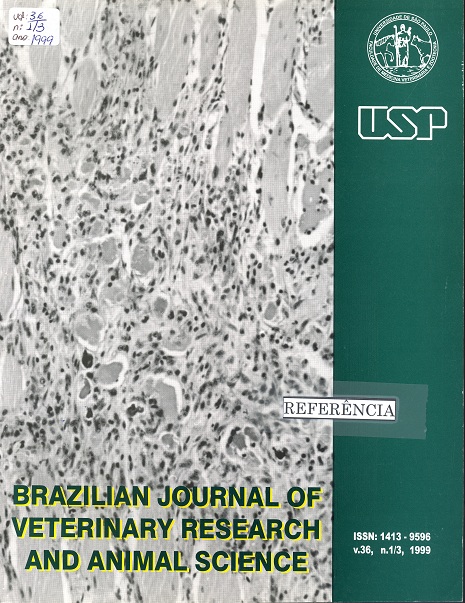Evaluation of preprandial and postprandial serum bile acids and plasma ammonia concentrations in healthy dogs, and the effects of frozen storage on plasma ammonia concentrations
DOI:
https://doi.org/10.1590/S1413-95961999000100005Keywords:
Bile acids, Ammonia, DogsAbstract
Preprandial and postprandial (2 and 4 hours) serum bile acids (SBA) and pre and postprandial (2 hours) plasma ammonia concentrations were evaluated. Additionally, the effects of freezing (for 24 and 48 hours at -20ºC) were observed on plasma ammonia concentrations in 22 healthy dogs. The preprandial SBA concentration was 2.1 ± 0.3 mmol/l and 7.5 ± 1.2 mmol/l and 7.8 ± 1.4 mmol/l for samples obtained 2 and 4 hours after feeding, respectively. Fasting and postprandial (2 hours) plasma ammonia concentrations were significantly different when measurement was performed within 30 minutes after blood collection (118.2 ± 13.2 mg/dl or 67.3 ± 7.5 mmol/l and 227.9 ± 59.2 mg/dl or 129.9 ± 33.7 mmol/l), but the difference between pre and postprandial concentrations was not observed when ammonia was measured in samples stored (-20º) for 24 and 48 hours. Plasma freezing makes ammonia concentrations fall considerably when these levels were initially too high, mainly in postprandial samples. From these results it may be suggested that canine plasma cannot be stored for later ammonia determination by using freezing as the sole stabilizer, and for SBA determinations, blood samples might be collected 2 or 4 hours after feeding. Plasma ammonia values obtained in this study should allow comparisons to data obtained from dogs with hepatic disease or hepatoencephalopathy, so as to confirm the importance of its use as means of diagnosis and prognosis in future.Downloads
Download data is not yet available.
Downloads
Published
1999-01-01
Issue
Section
VETERINARY MEDICINE
License
The journal content is authorized under the Creative Commons BY-NC-SA license (summary of the license: https://
How to Cite
1.
Kogika MM, Matsuura S, Hagiwara MK, Mirandola RMS, Ortolani EL. Evaluation of preprandial and postprandial serum bile acids and plasma ammonia concentrations in healthy dogs, and the effects of frozen storage on plasma ammonia concentrations. Braz. J. Vet. Res. Anim. Sci. [Internet]. 1999 Jan. 1 [cited 2026 Jan. 18];36(1):28-33. Available from: https://revistas.usp.br/bjvras/article/view/5776





